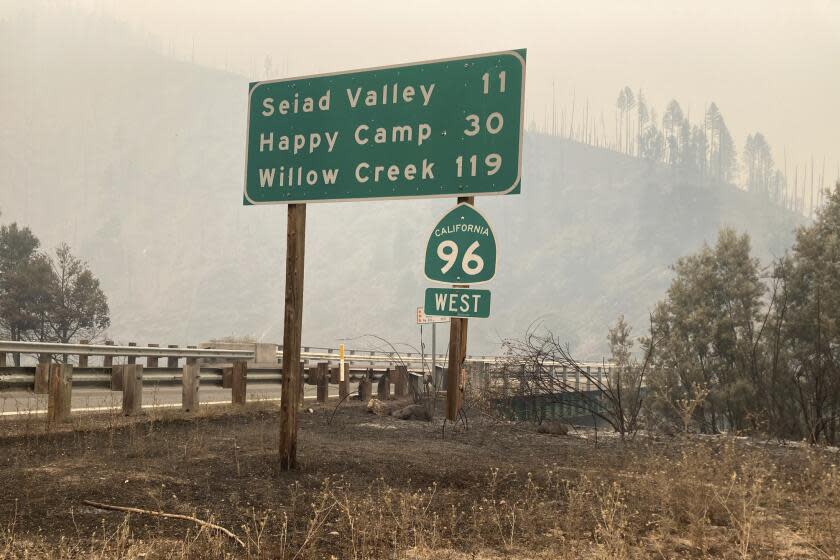Wildfires raging near California-Oregon border leave 1 dead, destroy at least 9 homes

Wildfires burning in the Klamath National Forest near the California-Oregon border have killed one person, scorched at least nine homes, blanketed valleys in thick smoke and prompted evacuation orders affecting hundreds of residents.
The Happy Camp Complex has scorched at least 11,616 acres and was 4% contained as of Wednesday morning, according to the California Department of Forestry and Fire Protection.
The complex is made up of several fires; the largest, the Head fire, has torched at least 6,419 acres. The other fires include the Canyon, Three Creeks, Elliot, Swillup, Ufish, Malone, Den, Townsend, Block, Gold, Scott and Lake.
The fires were sparked by relatively dry thunderstorms that moved across the Klamath National Forest on Aug. 14, bringing abundant lightning that ignited about 20 fires, according to the U.S. Forest Service.
Ken Lee Oliver, 71, of Scott Bar was found dead Aug. 16 at about 2:23 a.m. in the driveway of his home on Roxbury Drive after the area was evacuated due to the Head fire, according to the Siskiyou County Sheriff's Office.
The investigation is ongoing; an autopsy will be conducted to determine the cause of death.
Mike Lindbery, a spokesperson with the fire's incident management team, confirmed that the death occurred before the team arrived Thursday. The nine residences were destroyed in the initial phases of the fire in the area of Scott Bar.
As of Wednesday morning, 755 people were ordered to be evacuated and 1,609 structures were threatened, according to Cal Fire. An evacuation center has been set up at the Kahtishraam Wellness Center in Yreka. Residents can see evacuation orders in effect here.
Read more: Five years after the Camp fire, Paradise survivors see a hard future for Maui
Emergency closure orders for parts of the Klamath National Forest include a portion of the Pacific Crest Trail, which is closed between Etna Summit and the Oregon border.
Fire crews have contained 5% of the Head fire as of Wednesday morning and are building fire lines to the west and south from Collins Baldy Lookout, according to Cal Fire. Crews have also been taking advantage of a rise in the relative humidity overnight to 80% to 90%, using the wet conditions to construct fire lines along the edge of the blazes while fire activity was minimal.
Vegetation and brush are expected to dry out over the next few days, and the fires are expected to become more active as drier air moves into the region.
The Block and Townsend fires have been 100% contained, while the Den fire is 95% contained. The Gold fire has reached 40% containment; the Scott fire is at 35%. Fire crews were starting work on the eastern edge of the Swillup fire Wednesday while drones were expected to check for heat in the Canyon, Three Creeks, Elliot and Swillup fires.
Read more: Bodies of 18 people found in an area of a major wildfire in Greece
Crews have prepared structures along Highway 96 for fire defense as the fires on the west side are backing down to the highway, according to Cal Fire. The highway is currently closed, as debris and rocks have rolled onto the highway in the area of Dillon Creek. A tactical firing operation was planned for Wednesday night to bring the fire down to Highway 96.
Smoke from the wildfires, as well as several others burning in Oregon, has blanketed the far northern reaches of California and wide swaths of Oregon. The air quality index for the Scott Bar community was 190 on Wednesday afternoon, putting it at unhealthy levels, according to AirNow. People with lung or heart disease, children, older adults and teens are advised to avoid exposure by reducing time spent outdoors.
Another group of wildfires, the Smith River Complex, ignited Aug. 15 after about 150 lightning strikes sparked at least 27 blazes, according to officials. The fires have scorched at least 47,277 acres as of Wednesday and were 0% contained.
The fires have spread across the Smith River National Recreation Area, and the closest community is Gasquet, in Del Norte County, where evacuation orders are in place.
The Smith River Complex is burning in rugged terrain with limited access for fire crews, according to the incident management team. Although much of California had an exceptionally wet winter, the area where the fires are burning in the far north saw below-average rainfall, leaving vegetation unseasonably dry and susceptible to fire.
Sign up for Essential California, your daily guide to news, views and life in the Golden State.
This story originally appeared in Los Angeles Times.


